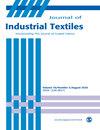沸石咪唑酸框架-8改性细菌纤维素/海藻酸钠复合气凝胶高效去除盐酸四环素
IF 2
4区 工程技术
Q1 MATERIALS SCIENCE, TEXTILES
引用次数: 0
摘要
水体中释放的抗生素对人类健康和生态健康构成严重威胁。因此,有效去除废水中的抗生素具有重要意义。采用化学交联法制备了可回收细菌纤维素/海藻酸钠/沸石咪唑酸骨架-8 (BC/SA/ZIF-8)气凝胶复合材料,并在冷冻干燥条件下原位生长。通过扫描电镜(SEM)、傅里叶变换红外光谱(FTIR)和x射线衍射(XRD)分析证实了复合气凝胶的成功制备。结果表明,BC/SA/ZIF-8气凝胶复合材料的BET比表面积为165.24 m2 /g,显著高于BC/SA的7.39 m2 /g。BC/SA/ZIF-8复合气凝胶对盐酸四环素具有优异的吸附性能,最大吸附量为746.27 mg/g。吸附过程遵循拟二级动力学模型和Langmuir等温吸附模型。此外,对BC/SA/ZIF-8复合气凝胶的重复使用试验表明,经过6次循环后,BC/SA/ZIF-8复合气凝胶的吸附量明显下降。因此,BC/SA/ZIF-8复合气凝胶作为一种新型的可回收吸附剂具有很高的潜力,可用于高效去除水中的盐酸四环素。本文章由计算机程序翻译,如有差异,请以英文原文为准。
Zeolitic imidazolate framework-8 modified bacterial cellulose/sodium alginate composite aerogel for efficient removal of tetracycline hydrochloride
Antibiotics released in the water pose a serious threat to human and ecological health. Therefore, it is of great importance to effectively remove antibiotics from wastewater. In this study, recyclable bacterial cellulose/sodium alginate/zeolitic imidazolate framework-8 (BC/SA/ZIF-8) aerogel composites were prepared by chemical cross-linking and in situ growth in freeze-drying. The successful preparation of the composite aerogel was confirmed by scanning electron microscope (SEM), Fourier Transform infrared spectroscopy (FTIR) and X-ray diffraction (XRD) analysis. The results reveal that BC/SA/ZIF-8 aerogel composite has significantly high BET specific surface area of 165.24 m 2 /g than that of BC/SA at 7.39 m 2 /g. The BC/SA/ZIF-8 composite aerogel exhibited excellent adsorption performance for tetracycline hydrochloride, with a maximum adsorption capacity of 746.27 mg/g. The adsorption process followed the pseudo-second-order kinetic model and Langmuir adsorption isotherm model. Moreover, the reusability test on BC/SA/ZIF-8 composite aerogel revealed an insignificant decline in adsorption after six cycles. Therefore, BC/SA/ZIF-8 composite aerogel has a high potential as a novel and recyclable adsorbent for efficient removal of tetracycline hydrochloride from water.
求助全文
通过发布文献求助,成功后即可免费获取论文全文。
去求助
来源期刊

Journal of Industrial Textiles
MATERIALS SCIENCE, TEXTILES-
CiteScore
5.30
自引率
18.80%
发文量
165
审稿时长
2.3 months
期刊介绍:
The Journal of Industrial Textiles is the only peer reviewed journal devoted exclusively to technology, processing, methodology, modelling and applications in technical textiles, nonwovens, coated and laminated fabrics, textile composites and nanofibers.
 求助内容:
求助内容: 应助结果提醒方式:
应助结果提醒方式:


